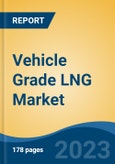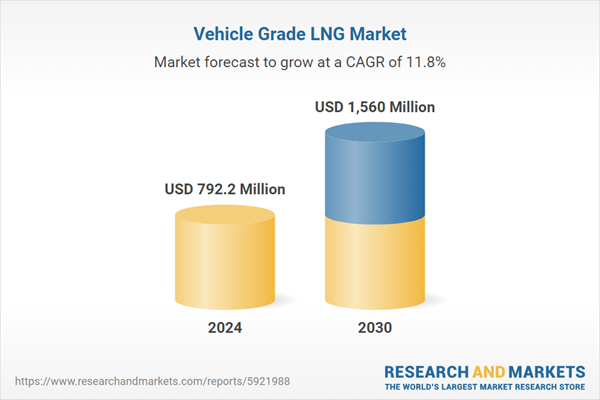Free Webex Call
Global Vehicle Grade LNG Market was valued at USD 792.2 Million in 2024 and is expected to reach at USD 1.56 billion in 2030 and project robust growth in the forecast period with a CAGR of 11.8% through 2030. The Global Vehicle Grade LNG (Liquefied Natural Gas) Market is experiencing significant growth, driven by the increasing demand for eco-friendly and cost-efficient alternatives to conventional fuels in the transportation industry. LNG, known for its lower emissions compared to diesel and gasoline, offers a viable solution to reduce the carbon footprint in commercial and freight transportation. Governments worldwide are implementing stringent environmental regulations that encourage the adoption of cleaner fuels, further propelling the market for vehicle-grade LNG. Speak directly to the analyst to clarify any post sales queries you may have.
10% Free customizationThis report comes with 10% free customization, enabling you to add data that meets your specific business needs.
The expansion of LNG fueling infrastructure and advancements in LNG-powered vehicle technology have also contributed to the market's growth. Major companies in the automotive and energy sectors are investing in LNG-powered vehicles, particularly heavy-duty trucks, buses, and marine vessels, to align with global sustainability goals and comply with emission standards. The market is also benefiting from LNG’s economic advantages, such as lower fuel costs, compared to traditional fuels like diesel, making it an attractive option for fleet operators.
Key Market Drivers
Cost-Effectiveness of LNG as a Fuel
One of the key drivers of the Global Vehicle Grade LNG Market is the cost-effectiveness of LNG as a fuel compared to conventional fuels. LNG is typically priced lower than diesel and gasoline, making it an economically viable option for fleet operators, logistics companies, and transportation providers. The lower fuel cost allows companies to save on operational expenses, making it an attractive option for businesses looking to reduce fuel costs and improve profit margins. Additionally, LNG offers better fuel efficiency for heavy-duty trucks, buses, and long-haul vehicles, further improving the overall cost-effectiveness for operators.As fuel prices continue to fluctuate globally, the economic stability that LNG provides is a key factor driving its adoption. The economic advantage is particularly appealing to industries with large fleets, such as freight transportation and public transit, further fueling the market’s growth. In China, the adoption of LNG-powered trucks has led to significant fuel cost savings. LNG is approximately 23% cheaper than diesel, resulting in a reduction of USD 0.138 per kilometer in fuel expenses compared to diesel trucks.
Key Market Challenges
Lack of Adequate LNG Refueling Infrastructure
One of the major challenges facing the Global Vehicle Grade LNG Market is the insufficient refueling infrastructure. Although LNG presents an environmentally friendly alternative to traditional fuels, the lack of a widespread and accessible network of refueling stations hampers its adoption, especially in regions outside of major urban centers. The current number of LNG fueling stations is limited, and establishing new stations requires significant investment in infrastructure development, regulatory approvals, and logistics. For fleets and long-haul operators, the lack of accessible refueling options remains a major barrier to the widespread use of LNG-powered vehicles.Additionally, the transportation of LNG to refueling stations involves complex logistics, including the need for specialized cryogenic equipment and tankers, further increasing costs and complicating distribution. To overcome this challenge, significant investment and coordination between governments, energy companies, and private investors are needed to expand LNG refueling infrastructure globally. Without adequate refueling options, vehicle operators may be hesitant to switch to LNG-powered vehicles, resulting in slower market penetration and growth.
Key Market Trends
Increasing Adoption of LNG in Heavy-Duty Transportation
The increasing adoption of LNG in heavy-duty transportation, particularly for long-haul trucking, is one of the most significant trends in the global Vehicle Grade LNG Market. With stringent emissions regulations and a growing emphasis on sustainability, fleet operators are seeking cleaner alternatives to traditional diesel engines. LNG, which emits significantly less carbon dioxide (CO2) and nitrogen oxides (NOx), offers a viable solution for reducing the carbon footprint of long-distance transportation. Furthermore, LNG vehicles provide longer driving ranges compared to electric vehicles, making them more suitable for long-haul operations.As global environmental policies continue to tighten, LNG adoption is expected to grow as a cleaner and more cost-effective alternative to diesel in the heavy-duty segment. This trend is further accelerated by advancements in LNG vehicle technologies, which have improved performance and efficiency, making LNG-powered trucks more attractive to fleet owners.
Additionally, large logistics companies and freight operators are increasingly investing in LNG-powered trucks as part of their sustainability initiatives. With the growing push for decarbonization in the transportation sector, the trend of LNG adoption in heavy-duty vehicles is expected to dominate the market, leading to substantial growth in the vehicle-grade LNG segment. With the expansion of LNG fueling stations, the number of LNG-powered trucks is also rising. As of 2023, over 20,000 LNG trucks were operating globally, with an expected increase to over 50,000 LNG trucks by 2030, driven by infrastructure expansion in key regions like China and Europe.
Key Market Players
- Exxon Mobil Corporation
- Chevron Corporation
- TotalEnergies SE
- BP PLC
- Engie SA
- Wärtsilä Corporation
- Siemens AG
- Cummins Inc.
Report Scope:
In this report, the Global Vehicle Grade LNG Market has been segmented into the following categories, in addition to the industry trends which have also been detailed below:Vehicle Grade LNG Market, By Vehicle Type:
- Heavy-Duty Trucks
- Buses
Vehicle Grade LNG Market, By End-User Industry:
- Transportation & Logistics
- Oil & Gas
- Others
Vehicle Grade LNG Market, By LNG Storage and Infrastructure:
- On-Site Storage
- Off-Site Storage
- LNG Refuelling Infrastructure
Vehicle Grade LNG Market, By Region:
- North America
- United States
- Canada
- Mexico
- Europe
- France
- United Kingdom
- Italy
- Germany
- Spain
- Belgium
- Asia-Pacific
- China
- India
- Japan
- Australia
- South Korea
- Indonesia
- Vietnam
- South America
- Brazil
- Argentina
- Colombia
- Chile
- Peru
- Middle East & Africa
- South Africa
- Saudi Arabia
- UAE
- Turkey
- Israel
Competitive Landscape
Company Profiles: Detailed analysis of the major companies present in the Global Vehicle Grade LNG Market.Available Customizations:
With the given market data, the publisher offers customizations according to a company's specific needs. The following customization options are available for the report.Company Information
- Detailed analysis and profiling of additional market players (up to five).
This product will be delivered within 1-3 business days.
Table of Contents
1. Product Overview
2. Research Methodology
6. Global Vehicle Grade LNG Market Outlook
7. North America Vehicle Grade LNG Market Outlook
8. Europe Vehicle Grade LNG Market Outlook
9. South America Vehicle Grade LNG Market Outlook
10. Middle East & Africa Vehicle Grade LNG Market Outlook
11. Asia Pacific Vehicle Grade LNG Market Outlook
12. Market Dynamics
14. Company Profiles
Companies Mentioned
- Exxon Mobil Corporation
- Chevron Corporation
- TotalEnergies SE
- BP PLC
- Engie SA
- Wärtsilä Corporation
- Siemens AG
- Cummins Inc.
Table Information
| Report Attribute | Details |
|---|---|
| No. of Pages | 185 |
| Published | March 2025 |
| Forecast Period | 2024 - 2030 |
| Estimated Market Value ( USD | $ 792.2 Million |
| Forecasted Market Value ( USD | $ 1560 Million |
| Compound Annual Growth Rate | 11.8% |
| Regions Covered | Global |
| No. of Companies Mentioned | 8 |









